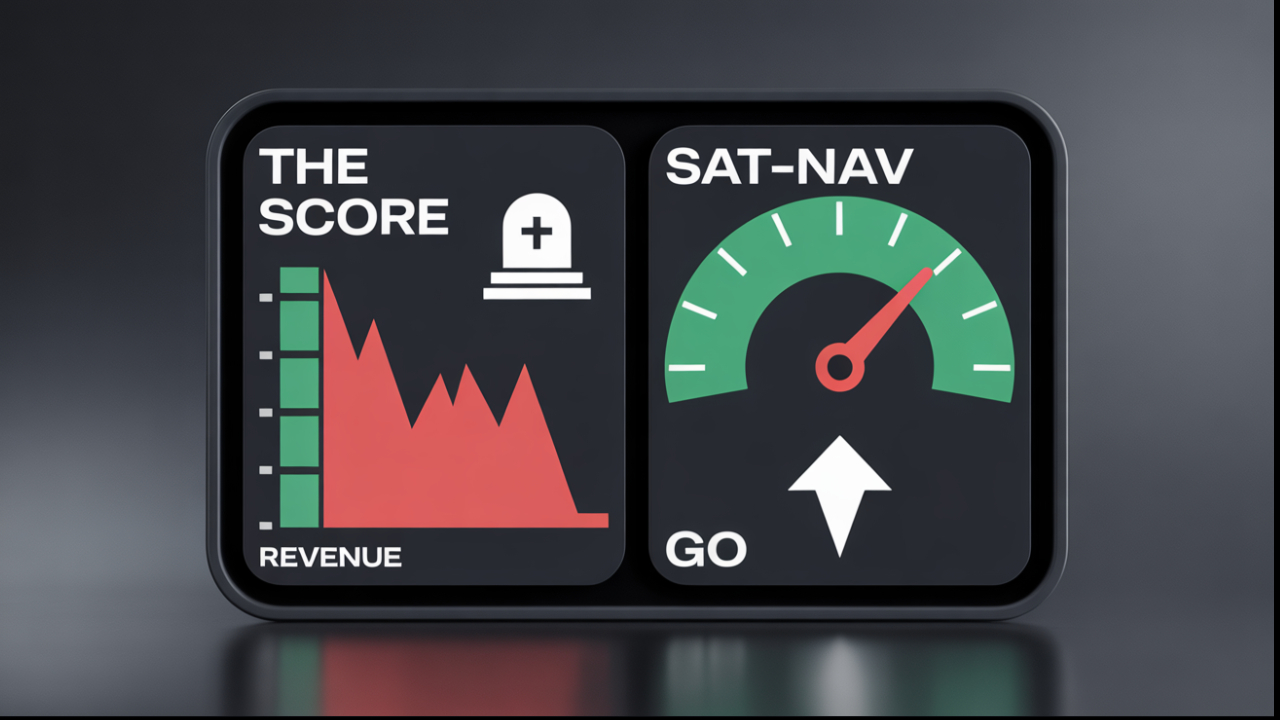Beyond the Bottom Line: Mastering the Art of Dual Planning for Small Business Success
You've likely worn many hats as a business owner—juggling marketing, customer service, finance, and perhaps even making the tea. Amidst this whirlwind, it's easy to conflate strategic planning with business planning, or overlook one in favour of the other. I recall when I first launched my own venture; the lines between day-to-day operations and long-term vision were blurred, and it wasn't until I understood the distinction that things truly began to click. Understanding the difference between strategic planning and business planning isn't just business jargon—it's a crucial element that can significantly impact your company's growth and sustainability. In this post, we'll delve into the key differences between these two types of planning and explore why mastering both is essential for your small business's success.
Time Frame and Focus: The Long Game vs. Immediate Action
When I started my first business, I was consumed by the immediate tasks—stocking inventory, attracting customers, managing cash flow. My focus was so laser-sharp on the present that I neglected to look ahead. This is where understanding the time frame and focus of strategic and business planning comes into play.
Strategic Planning: A 3-5 Year Outlook Anchored in Vision and Mission
Strategic planning is all about the big picture. It’s your roadmap for where you want your business to be in the next three to five years. It involves setting long-term goals based on your company's vision and mission. Think of it as plotting a course on a map; you need to know your destination to choose the right path.
For example, if your vision is to become the leading eco-friendly packaging supplier in the UK, your strategic plan will outline the steps to achieve that status. This might include investing in sustainable materials research, building partnerships with environmentally conscious brands, or expanding operations to new markets that value green initiatives. These steps are not just about immediate gains but are investments in the future, ensuring that your business remains relevant and competitive in a rapidly changing market.
Business Planning: A 1-2 Year Outlook Emphasising Day-to-Day Operations
On the other hand, business planning zeroes in on the immediate future—typically covering the next one to two years. It’s concerned with the nuts and bolts of your operation: budgeting, staffing, marketing strategies, and sales targets. It's about ensuring that the daily activities align with your short-term objectives and keep the business running smoothly.
When I adjusted my approach to include a solid business plan, I found that my team was more focused, and our operations became more efficient. We set quarterly sales targets, established a marketing calendar, and detailed our budget allocations. This granular level of planning kept us on track and accountable. It also allowed us to quickly identify areas that needed improvement and make necessary adjustments without disrupting our overall operations.
How Small Businesses Can Benefit from Both Perspectives
Balancing these two perspectives is crucial. While your business plan keeps the wheels turning today, your strategic plan ensures you're heading in the right direction for tomorrow. By integrating both, you can make informed decisions that serve immediate needs without losing sight of long-term goals.
For instance, if your strategic plan involves becoming an industry leader, your business plan might include actions like upskilling your workforce or investing in new technology—steps that have immediate costs but serve your long-term vision. This dual approach ensures that every short-term action is a building block towards achieving your larger objectives, creating a cohesive strategy that aligns all aspects of your business.
Purpose and Stakeholders: Setting Direction vs. Securing Resources
Understanding who your plans are for and what they aim to achieve can clarify their roles in your business.
Strategic Planning: Providing a Roadmap for Future Growth and Aligning Stakeholders
The primary purpose of a strategic plan is to set your business's direction. It's about aligning everyone—from employees to board members—around a common vision. This plan communicates your long-term goals and the strategies to achieve them.
In my experience, sharing our strategic plan with the team fostered a sense of purpose. Employees weren't just clocking in; they were contributing to a larger mission. This alignment can boost morale and productivity, as everyone understands how their role fits into the bigger picture. It also encourages innovation, as team members feel empowered to contribute ideas that align with the strategic goals.
Business Planning: Outlining Operational Structure and Securing Funding
Conversely, a business plan is often geared towards external stakeholders like investors, banks, or potential partners. It outlines your operational structure, market analysis, revenue models, and financial projections. This plan demonstrates the viability of your business and can be crucial when seeking funding.
I remember when I sought a loan to expand a business’s facility. The bank was less interested in the long-term strategic goals and more focused on the business plan's details—cash flow statements, profit margins, and market analysis. Having a robust business plan was essential in securing the necessary funding. It provided the concrete evidence needed to convince lenders of our business's potential for success and profitability.
Why Small Business Owners Need to Consider Both Internal and External Audiences
Balancing both plans ensures you're addressing the needs of all stakeholders. Internally, your strategic plan keeps your team aligned and motivated. Externally, your business plan provides the information investors or lenders need to assess your business's viability.
By considering both internal and external audiences, you can create comprehensive plans that drive growth and secure the resources needed to achieve your goals. This dual focus ensures that your business is not only operationally sound but also strategically positioned to capitalise on future opportunities.
Flexibility and Integration: Adapting to Change vs. Maintaining Stability
In an uncertain world, flexibility and stability are both essential for success.
Strategic Planning: Allowing for Refinement as Strategies Evolve
Strategic plans are not set in stone. They should be revisited and revised as market conditions change, new opportunities arise, or your business evolves. This flexibility allows you to adapt your long-term strategies without losing sight of your overarching goals.
For example, during a recent surge in online shopping, many small businesses had to pivot their strategic plans to incorporate e-commerce solutions. Adjusting your strategic plan ensures you remain relevant and competitive in a changing market landscape. It also allows you to seize new opportunities that align with your long-term vision, ensuring sustained growth and success.
Business Planning: Focusing on Stable, Short-Term Goals and Tactics
Business plans, while adaptable, typically maintain more stability to ensure consistent daily operations. They provide a clear framework for the short term, focusing on achieving specific targets and maintaining operational efficiency.
In my own business, we adhered closely to our business plan's budgets and schedules. This stability was crucial for managing resources effectively and meeting our short-term objectives. It also provided a reliable foundation upon which we could build and expand, knowing that our core operations were secure and efficient.
How Small Businesses Can Integrate Both Plans for Optimal Results
Integrating flexibility and stability means using your strategic plan to guide long-term adjustments while relying on your business plan to manage day-to-day operations effectively.
One approach is to schedule regular reviews of both plans. Perhaps quarterly for your business plan and annually for your strategic plan. This allows you to make necessary adjustments in response to internal performance metrics and external market shifts.
In practice, when we noticed a decline in foot traffic to our physical store, our business plan adjustments included ramping up online marketing efforts. Simultaneously, we revisited our strategic plan to explore long-term strategies for digital transformation. This integrated approach ensured that we could respond to immediate challenges while also positioning ourselves for future success.
Key Takeaways
Mastering both strategic and business planning isn't just beneficial—it's essential. Strategic planning sets your compass, ensuring you're heading towards your long-term vision, while business planning maps out the steps you'll take today and tomorrow to get there.
Reflecting on my journey, the turning point was when I embraced both planning types. The synergy between the two provided clarity, aligned my team, and secured the resources we needed. It allowed us to navigate the immediate challenges without losing sight of our ultimate goals.
Remember, your strategic plan fuels your ambition and guides your business towards future growth. Your business plan grounds you, providing the operational blueprint to make that journey possible. In understanding and leveraging the strengths of both, you position your small business not just to survive, but to thrive in today's competitive market.
So, take the time to develop both plans thoughtfully. Engage with your team, seek feedback, and be willing to adapt. Your business's future is in your hands, and with the right planning, there's no limit to what you can achieve. By fostering a culture of strategic thinking and operational excellence, you can ensure that your business not only meets its current objectives but also lays the groundwork for long-term success and sustainability.
In conclusion, the integration of strategic and business planning is not merely a theoretical exercise but a practical necessity. It is the bridge that connects your present operations with your future aspirations. Dedicating time and resources to both, you create a resilient business model capable of withstanding market fluctuations and seizing new opportunities. This comprehensive approach not only enhances your business's adaptability but also its potential for innovation and growth. As you move forward, remember that the strength of your business lies in its ability to plan effectively, adapt swiftly, and execute efficiently. With these tools at your disposal, your business is well-equipped to navigate the complexities of the modern marketplace and achieve lasting success.
If you need support in mastering strategic and business planning for your business, don't hesitate to reach out to us. Our expert team is ready to assist you in developing a robust strategy tailored to your unique needs.
Contact us today to take the next step towards a more resilient and innovative future for your business.
Pay It Forward! Sharing Is Caring!











